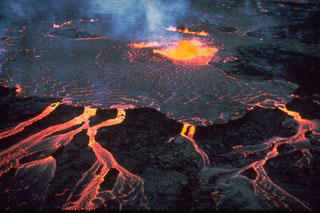Report on Kilauea (United States) — October 1988
Scientific Event Alert Network Bulletin, vol. 13, no. 10 (October 1988)
Managing Editor: Lindsay McClelland.
Kilauea (United States) Repeated collapse of new coastal lava benches
Please cite this report as:
Global Volcanism Program, 1988. Report on Kilauea (United States) (McClelland, L., ed.). Scientific Event Alert Network Bulletin, 13:10. Smithsonian Institution. https://doi.org/10.5479/si.GVP.SEAN198810-332010
Kilauea
United States
19.421°N, 155.287°W; summit elev. 1222 m
All times are local (unless otherwise noted)
. . . lava continued to flow into the ocean from the tube system near Kupapau Point through October. Some minor surface activity occurred 2-4 October when lava broke out from the tube system between 300 and 180 m elevation.
The coastal lava bench growth and collapse sequences continued. A major collapse on the 13th removed ~2/3 of the 220 x 30-40 m bench, and there were minor collapses on 20 and 29 October and 5 November. Benches collapsed suddenly, without warning, making viewing the coastal area very hazardous. Small littoral cones formed periodically, the largest 10 m high. They were soon stranded behind the growing shoreline, then destroyed as the benches collapsed. Pyroclastic material consisting of fine shards and Pele's hair was ejected by littoral explosions, forming a tephra blanket several centimeters thick > 250 m downwind.
The lava pond at Kupaianaha remained 15-28 m below the rim. A 5-m-diameter "island" was visible 15-24 October ~20 m from the pond's edge, probably a piece that had collapsed from the rim. Activity increased in Pu`u `O`o crater on 26-27 October, with lava covering ~25% of the crater floor. Lava appeared to well up through one of the two active vents on the crater floor, and drain back down the other.
Low-level tremor continued . . . near Pu`u `O`o, Kupaianaha, and the Wahaula station near the coastal lava flows. East-rift tremor showed steady amplitude until the 27th, then changed to a pattern of varying amplitude that produced a banded pattern on the revolving drum seismic recorders. High-amplitude tremor lasting < 1 hour typically alternated with several hours of low-amplitude tremor. The fluctuating tremor continued until 4 November, then resumed its typical steady pattern. Bursts of deep tremor . . . increased from last month. The number of microearthquakes was about average in the summit region and East rift zone. There were 12 earthquakes of M 2.6-4.1, mostly centered beneath Kīlauea and Mauna Loa.
Geological Summary. Kilauea overlaps the E flank of the massive Mauna Loa shield volcano in the island of Hawaii. Eruptions are prominent in Polynesian legends; written documentation since 1820 records frequent summit and flank lava flow eruptions interspersed with periods of long-term lava lake activity at Halemaumau crater in the summit caldera until 1924. The 3 x 5 km caldera was formed in several stages about 1,500 years ago and during the 18th century; eruptions have also originated from the lengthy East and Southwest rift zones, which extend to the ocean in both directions. About 90% of the surface of the basaltic shield volcano is formed of lava flows less than about 1,100 years old; 70% of the surface is younger than 600 years. The long-term eruption from the East rift zone between 1983 and 2018 produced lava flows covering more than 100 km2, destroyed hundreds of houses, and added new coastline.
Information Contacts: C. Heliker and R. Koyanagi, HVO.

